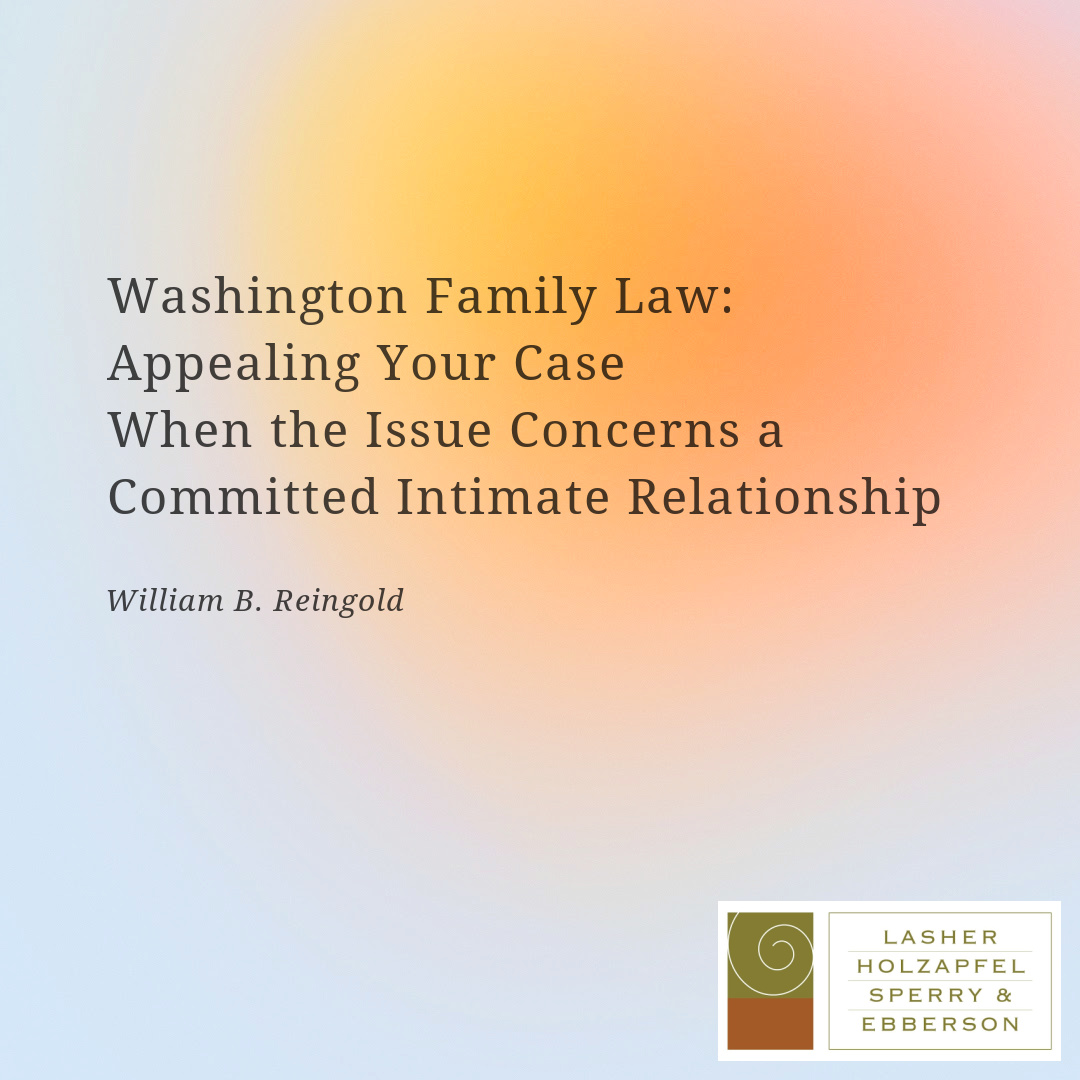Washington Family Law: Appealing Your Case When the Issue Concerns a Committed Intimate Relationship

Posted on September 20, 2022 by Will Reingold
I have previously blogged about Committed Intimate Relationships (“CIR”) and how courts handle them at the trial level, which you can read about here and here. In addition, CIR have also been reviewed by the Appellate and Supreme Court of Washington. Succinctly, the Supreme Court of Washington recognizes CIR as an equitable doctrine “because the legislature has not provided a statutory means of resolving the property distribution issues that arise when unmarried persons, who have lived in a marital-like relationship and acquire what would have been community property had they been married, separate.”[1] This blog concerns a situation in which one party appeals the trial court’s determination that a CIR did, or did not, exist.
First, let us discuss what the appellate court is reviewing. CIRs present a mixed question of law and fact.[2] So while the appellate court will review the trial court’s division of property following a CIR for an “abuse of discretion,” it will review “de novo” the trial court’s legal conclusion that a CIR existed in the first place.[3] (Check out another one of my blogs here for an explanation as to what the terms “abuse of discretion” and “de novo” mean in practice.) The appellate court’s analysis proceeds in three steps:
- Review de novo the legal conclusion that a CIR existed.
- If such a relationship did exist, identify when it ended. This review is an issue of fact under the abuse of discretion standard.
- Finally, review whether the trial court’s distribution of property acquired during a CIR was just and equitable. This is also under the abuse of discretion standard.[4]
To the first step, the trial court will make factual findings that it bases its legal conclusions, and the appealing party will have the chance to challenge those findings for what is known as “substantial evidence”—i.e., evidence that would “persuade a rational, fair-minded person of the truth of the declared premise.”[5] You do not have to challenge the factual findings; but unchallenged findings will be treated as verities on appeal, meaning you will only be able to argue about whether the trial court’s legal conclusion—whether there was or was not a CIR—drawn from those findings was correct.[6] Accordingly, the appellate court will review de novo the typical factors used to determine whether a CIR existed, just as the trial court did previously. Those factors include (1) continuity of cohabitation, (2) duration of the relationship, (3) purpose of the relationship, (4) pooling of resources and services for joint projects, and (5) the intent of the parties.[7] If the appellate court concludes that a CIR did not exist, then the analysis stops.
If, on the other hand, the appellate court concludes that there was a CIR, then the analysis proceeds to the next step to review when the CIR ended. The party appealing the case will need to challenge the trial court’s finding to show there was an error in determining when the CIR concluded. As an example of what this might look like, in the case of Muridan v. Redl, the appellate court explained as follows: “The parties cohabitated for over six years, during which time they raised a child together and lived as a family. They lived together as a couple until Muridan ended the relationship in February 2015. It is uncontested that Muridan ended the relationship on February 27, 2015, when he learned of Redl’s pregnancy. The trial court’s finding that the relationship ended on that date is therefore an unchallenged finding of fact and a verity on appeal.”[8]
The third and final step makes a division of the community-like property acquired during the CIR, using the date the CIR began and ended, as established in the second step. The property acquired during the CIR is presumed to be community-like, but this may be rebutted upon a showing that it is actually separate property.[9] This portion of the appeal strongly resembles a typical divorce in how property is divided; however, separate property will not be part of the division of assets like in a divorce setting—only the community-like property is on the table.[10]
In case it is not apparent by now, there can be a lot going on in a CIR appeal. If you have questions about how to navigate a possible appeal, reach out to a family law attorney at Lasher Holzapfel Sperry & Ebberson for assistance and possible representation.
[1] Vasquez v. Hawthorne, 33 P.3d 735, 738 (Wash. 2001) (en banc) (Alexander, C.J., concurring)
[2] In re Marriage of Pennington, 603, 14 P.3d 764, 770 (Wash. 2000) (en banc)
[3] In re Muridan v. Redl, 413 P.3d 1072, 1077–79 (Wash. Ct. App. 2018).
[4] Id.
[5] In re Marriage of Fahey, 262 P.3d 128, (Wash. Ct. App. 2011).
[6] Muridan, 413 P.3d at 1078.
[7] Connell v. Francisco, 898 P.2d 831, 834 (Wash. 1995) (en banc).
[8] Muridan, 413 P.3d at 1081.
[9] Connell, 898 P.2d at 836.
[10] Id.

